Chapter Thirty-One
Reaching the Summit
From 1996 to 1999 Gurudeva centered his life at the monastery, working more than ever with the monastic kulams, pushing projects through. A special group invited him to join their small and elite circle. Called Vision Kauai 2020, it was composed of the island’s leaders: political, business, educational, agricultural. Gurudeva was the sole spiritual leader on this council, and he brought to their table his gifts. Mayors and former mayors, journalists and thinkers all came together each month to imagine and articulate the future of the island and her people, and to hear what Gurudeva had to offer. He and his monks became the driving force for the group, and much was accomplished during these years. Ron Kouchi, then the County Council head, told the monks, “The only reason I attend these meetings is to see what Gurudeva will do next! He’s the most amazing person I have ever met.”§
Progress on the trilogy was intense. Every day, without fail, Gurudeva would board his RV and head for the ocean side with his editing team. Even on days off, even on festival days, this was an appointment he never failed to keep. It was, for him, the purpose of his vrata to stay on the island, and he was determined to complete the work. §
He and the editing team completed the fifth edition of Dancing with Siva in 1997, then dove into Merging with Siva. Gurudeva took special delight in this book, for it was his mystical and metaphysical summation, an opus that would contain and thus preserve a lifetime of insights, lessons, talks and recorded moments. He subtitled it “Hinduism’s Contemporary Metaphysics,” for metaphysics were, to him, the bone of life on which all else finds its support. §
He named 1998 the “Year of Merging with Siva.” Day after day he sat in the cramped end of the RV, with windows looking out on the Pacific Ocean, whose waves crashed on the rocks just a few yards away. Day after day he crafted the chapters, tweaked the language and offered new writings to fill a discovered lacuna. Month after month he muscled the writing forward, reviewing galley after galley as each section was brought back to the table for review. It became his great joy to share chapters with the monks as they were finished. After a full year of assembling, editing, illustrating and polishing, Merging with Siva was released. A few months later, Gurudeva described it for the world: §
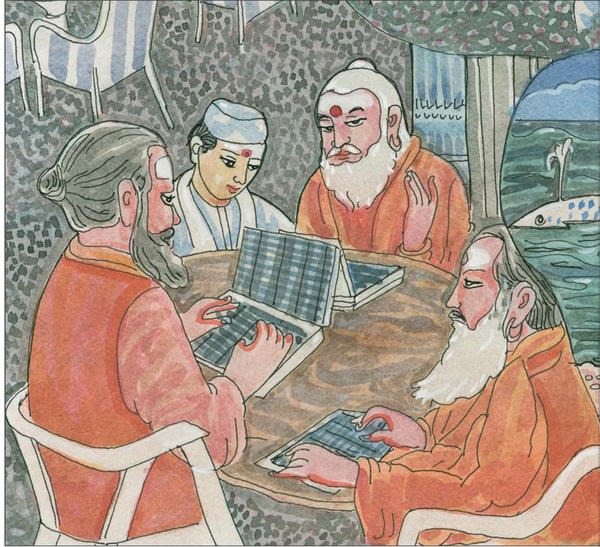
Every word of every publication was meticulously reviewed by Gurudeva at the editing table. He stressed working collaboratively and loved the technology that allowed his team to work on the same document from four different computers—something new in those days.
• • • • • • • • • • • • • • • • • • • • • • • •§
Merging with Siva is a book unlike our other books. It’s a book all about you; about the inside of you—how your mind works with your emotions, your emotions with your physical body, and the real goal of life, which is Self Realization. My Sri Lankan devotees in Canada, in Sri Lanka itself, in Europe and scattered out among the world because of the war have found it a very useful book to help get a new lease on life, a new self-image that we are a soul living in a physical body, living in an astral body, having an intellect, but we are a pure soul—untarnished, unblemished—living through the karmas of this life. §
Unlike other metaphysical books, which take you away from the world into high philosophy, Merging with Siva (which also does that) provides techniques and sadhanas for making you successful in the world so that you can move the forces of the world because you control your awareness that flows through the mind like a traveler that travels around the world, from city to city, state to state, from place to place. We celebrated our fiftieth anniversary of my ministry and teaching of philosophical subjects and metaphysical sadhanas by releasing Merging with Siva in five countries. §
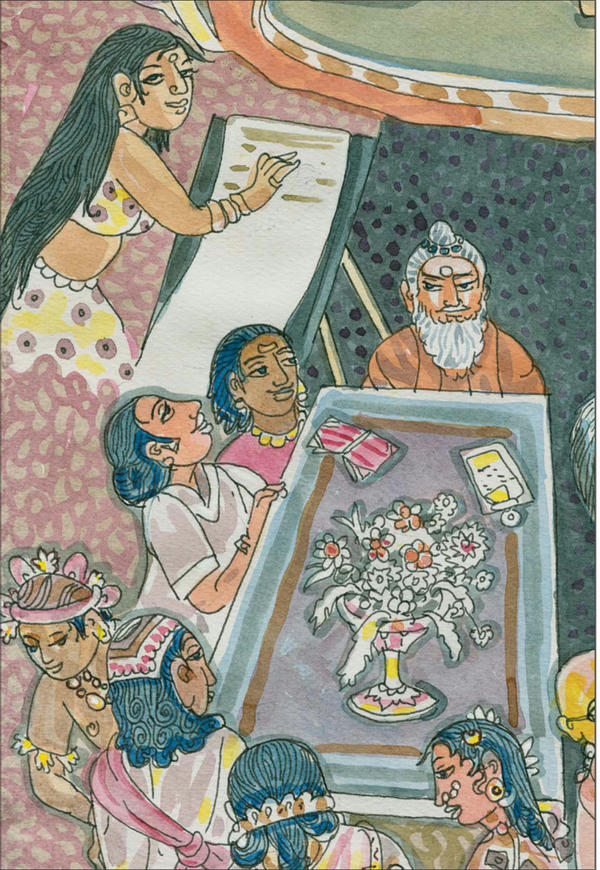
For five years Gurudeva met monthly with the business, educational, media and political leaders of the island, their sole purpose being to map out a spiritual vision for the future of Kauai.
• • • • • • • • • • • • • • • • • • • • • • • •§
One day Gurudeva drove to the sea, only to discover that his favorite ocean-side parking spot had been blocked off with giant boulders—part of a project to create a bicycle and walking path near the beach along the east side of the island. Unable to return to that magical spot, he soon bought a condo right on the ocean, not far away, which from 1998 on served as his editing headquarters. This spacious new facility allowed him to take an afternoon swim in the ocean before each session and even to stay overnight if he was so inspired. He called it Hale Makai, his “home by the sea.” Like Yogaswami, he loved the daily excursion to the ocean. For safety, he and his trio of editors held hands to keep from falling as they traversed the treacherous coral to enter the warm waters. Gurudeva loved to watch the tropical fish and to float on his back, buoyed softly by the waves.§
On January 5, 1998, the monks surprised Gurudeva with a birthday party, given in part to ease his rock fever (the island variety of cabin fever) and because his birthday had never been celebrated by the whole island. After months of secret planning (the monks knew he knew everything, but neither they nor he uttered a syllable), he was cajoled, though he did not know the destination, to board a helicopter that was waiting in an open meadow on the monastery grounds. §
Three minutes later the craft circled Kilohana Mansion, a famed Kauai estate, then landed amid a jubilant crowd to begin an amazing night of recognition and joy. Four hundred island people who had grown to love Gurudeva greeted him. Hawaiian dancers and chanters led the elegant satguru to the hall where everyone was gathered to surprise him. §
That night he danced with the Mayor, Maryanne Kusaka, she leading him in a hula and he leading her in a Manipuri dance on stage. That night his Church members placed him on a giant makeshift scale, adding gold-colored bricks until the other side balanced, then writing a check for nearly $900,000—the price of his weight in gold—and offering their pledge to raise that amount for his Iraivan Temple, which they did in the months ahead. That night his life was reviewed, gifts given, memories recounted and appreciations offered for his contributions to the island. He felt and looked like a monarch that night, surrounded by so much love and gratitude for his life.§
Never, several said later, had such a diverse group of islanders gathered under one roof, noting Gurudeva had touched every stratum of the community, from top to bottom. It was officially his 71st birthday, but he thought of it as his 72nd, following the Indian system in which conception marks the beginning of life. Age 72 is recognized in Hinduism as a major milestone, marking the beginning of life’s fourth stage, the sannyasa ashrama, and it was important to Gurudeva. §
Exploring Inner Worlds through Shum
Throughout his life Gurudeva had an inner and an outer existence, the two having little communion. While on an Innersearch, he would retreat into his meditations when rare free moments presented themselves. During a typical day, he would have work to do psychically, always being ready, when the external mind called, to come to lunch, join his editing team or see a pilgrim. §
During the 1990s, those precious hours of inner work revolved around Shum, his language of meditation. He would rise at two or three in the morning to work on Shum before the day started, refining and organizing the vast Shum database and lexicon that he had developed through his inner explorations over the decades. Several monks were assigned various tasks to assist his efforts. But for Gurudeva, it was all about describing the subtle world that was, he assured, more solid than this plane. §
He was, in a sense, like an explorer who daily visited a land no one else saw, returning again and again to describe and map that magical territory for others, excited to tell them that there was such a land and that they could also visit it one day. In later years he explored the dimensions of the mind, describing fourteen worlds containing, or more exactly constructed of, unearthly colors and forms and sounds. Here he describes the intuitive realm, or fourth dimension. §
The fourth dimension then is the subsuperconscious faculty of man. It is a beautiful place to be, and you can be there all of the time by feeling the power of your spine. The minute you feel that radiant energy in the spine, you are disconnected from the third dimension and soar into the fourth. §
Artists are in the fourth dimension. Each time you designed or created anything, you were bringing the beauty of the within through your nerve system into manifestation. Didn’t your whole nerve system feel good? That was the subsuperconscious fourth dimension of you. It finds expression in the creative intellect that wants to know for the good of the other fellow, that seeking to know. §
We say a person is open-minded, more willing to listen than to banter back his own ideas at you, he is conscious in the fourth dimension. He’s a new age person. When he says something, it’s because he has something to say, and generally his perspective of looking at the world is quite different from the material attitudes of people around him. He is able to see all four sides of a subject at the same time and to understand what people mean even if their viewpoint differs from his own. He is inspirational. He has and enjoys happiness. He is creative, unique, and works out of the box. He is independent, relying on himself and the power of his spine. He is quick to help others but slow to get entangled with their third-dimensional forces. He is highly motivated with well-defined purposes and goals. He expends his energy well, not wasting or draining the power that propels him onward and inward. He is enthused, charmed with life, charged with great desire to pursue the spiritual path.§
That’s the fourth dimension of the mind—a wonderful place to live and to bring through inner unfoldment, for you then have the continuity of creative thought. From the fourth dimension you can see the panorama of life unfolding flawlessly day to day. You can look deeply into the subconscious, cognize and understand the chemistry of feeling, thought and reaction. You can look into the magnetic force fields of the third dimension and comprehend the processes by which different people relate to one another. §
It’s very easy to get into the fourth dimension, very easy. It’s a little more challenging to hold that detached perspective when things are not going as well as we would like, but then its easy to return when the forces smooth out. §
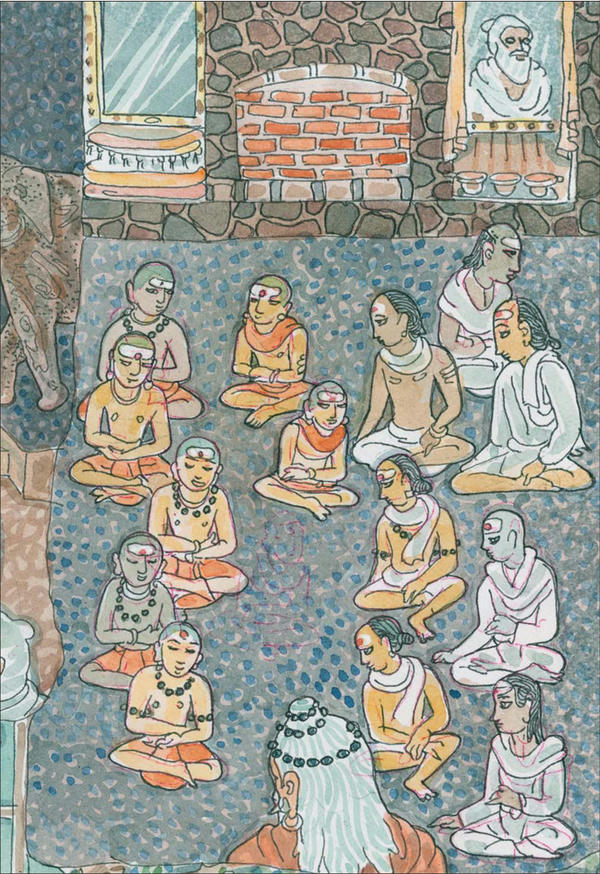
Each morning before dawn, Gurudeva sat on his lion seat in the Guru Pitham. With the monks seated facing him, he would guide their yogic meditation for an hour, all in the Shum language.
• • • • • • • • • • • • • • • • • • • • • • • •§
A Typical Day at Home
Gurudeva loved to travel. Except for his three-year retreat, he was away from the monastery some two or three months a year—called to open a temple, visit his initiated members, attend a conference. At home, his days were richly filled with a mind-numbing to-do list, which, harnessed by good habits, he met with elan. §
On most days, he rose even earlier than the monks, showered and walked downstairs to his Mahogany Room, the office finished in that hard wood for him when he renovated the old estate house. After he had been working at his desk for some time, a monk would arrive with hot tea or coffee. Gurudeva would chat with the early visitor awhile about inner things or a vision that occurred last night and then dismiss him, turning to his computer to sort through the first emails of the day, check the calendar and, twice a week, prepare for his temple talks. These were quiet moments he cherished, the lull before the day began, a time often for his Shum work, which was not work for him at all but a consuming passion where hours spent seemed like moments.§
Sharp at 5:15 he took the short walk to Kadavul Temple, where the monks gathered each day for Siva puja. He would greet Siva with hands pressed together, then walk through the temple’s main hall to sit in the back corner in a tall-back wicker chair.§
As the monks gathered before the puja, each would offer him a flower, lovingly touch his feet, prostrate and then sit nearby to enjoy a few informal moments together with their guru. At 5:30, Gurudeva would stand for an arati for Ganesha and Murugan before walking up to the inner sanctum, taking his special seat just a few feet away from Siva Nataraja. There he sat erect, immersed in what he called “outer worship.” “First external worship, then internal worship,” he smiled, noting that both are essential for an ego-negating immersion in true Saiva Siddhanta, which sees God within man and man living literally within the being of God, as the world. §
At 6:00 the puja ended, and he would stand and thread through the temple catacombs to the adjacent Guru Pitham. He always brought a flower from the Siva sanctum to offer at the small Yogaswami shrine, worshiping his guru alone each morning, before the monks gathered, just as Yogaswami had worshiped Chellappaswami in the form of his sandals.§
Taking his seat cross-legged on the traditionally designed simhasana, “lion seat,” he would sip a little coffee brought by one of the monks as the others arrived and took their yogic seat in four neat rows on the floor before him. Gurudeva chanted “Aum” to set the day in motion; then the monks chanted the Guru Mantra together in Sanskrit and recited, twice, the cadenced affirmation he had created as the monks’ mission statement, expressing their shared purpose and goals. §
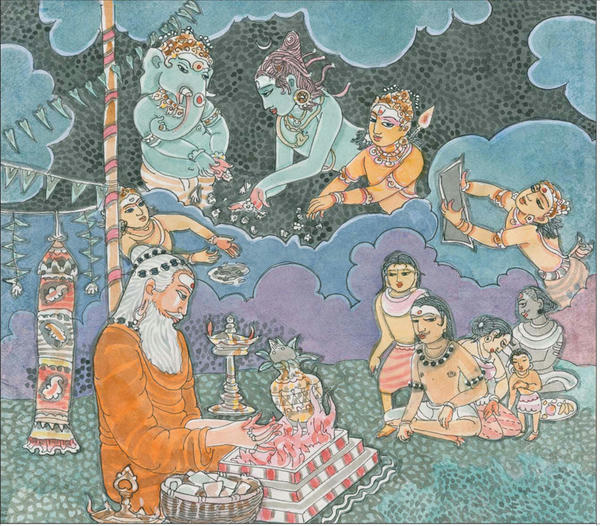
Gurudeva made a pact with the devas, arranging for written prayers to be transmitted through the sacred fire. Each week he would consign to the fire a basket of prayers sent in from devotees around the world. He explained that their astral double would appear in the Second World to be read by the devas, who could help answer each prayer.
• • • • • • • • • • • • • • • • • • • • • • • •§
An acharya led the preparation for meditation, a 15-minute quieting of the mind and systematic going within. When that reached a crescendo, Gurudeva led the final ascent, in Shum, taking his monks to the top of the mountain. It may well have been the only such perfectly synchronized meditation on the planet, with all following the same inner trajectory, guided by the guru and his Shum language. §
As some monks fought to fend off what was playfully called “snormadhi,” the veterans among them dove into the light and the Self. Gurudeva sat ramrod straight, so at ease with the discipline that challenged others, so poised and clearly in-turned. His body itself was radiant in those sessions, a testament of divine transformation and a constant inspiration of the possibilities of kundalini yoga for all his monks, the only ones privileged to attend this daily deep-see dive into the divine. After an hour, the meditation was concluded. §
Gurudeva usually spoke after the meditation. Sometimes he would say a few words about the day, preparing the troops for the morning-to-evening march, noting the arrival of guests or a project that would involve everyone. Sometimes he spoke of inner effort, of sadhana. About this time he began a long series of upadeshas directed toward the monks and their life. He called these talks his Mathavasi Shastras. They ranged from two to forty-five minutes long, and each was laser-focused on the ideals of a monastic, the dos and don’ts of living in his monastery. Here is one he dictated which he called “Obedience and the One Mind:”§
At Kauai Aadheenam everyone is obedient to their vows; so, then, they are obedient to everyone else. We have one great intelligence here; we don’t have a lot of people here. There is no individual person here; it’s just one intelligence. A lot of people blending their minds together with a lot of other people makes a one big mind. That’s why we can influence people through HINDUISM TODAY and our publications, because someone reading one of our publications tunes into this one big mind. We have up to twenty-five minds blended together—merged together—in obedience to their own inner self and cooperation with one another for the greater good. §
Now, if we had a situation here where everyone had their own preferences, “I want to do this, and I don’t want to do that,” and, “I would rather be doing something else. But do I have to do this?” Then we would have a lot of people here—people who would read our publications, and say, “Well, that’s really nice, what they’re doing; the pretty pictures are nice.” There would be no magnetism to tune into. But because we have isolated ourselves from the world and the family community, because we isolated ourselves by blending our minds together as a one group (we’re not blending our minds with the family group, we’re blending our minds with our own group), we have become like a big person, one big mind with a whole lot of bodies. §
So, someone reading Dancing with Siva, reading HINDUISM TODAY, tunes into this one big intelligence and becomes a part of it for the short time they are reading what we have given from this great intelligence. That’s all from the vow of obedience.§
He was bold in those moments, addressing issues that were typically not discussed aloud, certainly not in such a general setting. When they were all spoken, these talks stood as an amazing body of spiritual insight and principle, systematically articulated and carefully recorded for future generations. It was to be a final call to his soldiers of the within, those in the room and those who one day would be, his warning of the perils of weakness on the path, his praise of the powers of living a strong renunciate life, his instructions for how to live dynamically and harmoniously together. He would even scold monks mildly during these sessions, pointing out little things they should do better and praising small accomplishments that were, to him, signposts of progress on the path. §
Then, when the crescendo was reached, he would smile broadly and wish each one a good day before beginning the singing of “Aum Namasivaya,” which all would chant as they came forward, one at a time, in order of seniority, to kneel and touch his feet, receive a daub of holy ash on the forehead from his right thumb and leave the Guru Pitham on their way to perfection. §
The first to arrive, Gurudeva was always the last to leave the meditation, often staying on for a few minutes to meditate a while longer or talk with a monk who had something on his mind to share.§
A short morning walk in the garden often followed, then breakfast served in his Mahogany Room—fruits and yogurt, or his favorite: mung beans and spicy coconut chutney, Jaffna style. On most days, breakfast segued into a rainbow of duties that he loved, for each of them was a small part of the mission he had spent his life building. If he had major issues on his mind, he would call a meeting of the monks involved. He seldom delayed in handling issues, preferring to mount an immediate assault and resolve them right now. §
Absent such a meeting, his habit was to turn to the list of the day, editing a Publisher’s Desk editorial, emailing responses to his shishyas around the world who might be asking about a new name for their baby, advice on a business decision, what to do with grandma’s ashes or how to avoid a threatened divorce. The list went on, hour after hour—preparing for stewards’ meetings, resolving petty conflicts between monks, communicating by phone and email with shishyas, satsang groups and branch monasteries, and guiding thirty or more kulapati families and a half dozen Church missions in several countries. §
When that was done, there was more: resolving financial and legal issues, guiding temple boards of trustees, gathering with groups of monks handling projects, fielding editing questions, publishing questions, public relations questions. He kept close to the business of the monastery, signing all contracts and bank loans and each and every check. In the midst of all this were spontaneous meetings with the monks throughout the day. His door was always open, and “no one need make an appointment to see the guru.”§
This all came to a temporary halt whenever pilgrims were waiting for his darshan. He loved visitors and considered their arrival to be the arrival of Siva Himself. Greeting pilgrims was a central duty, and he told the monks, “The only reason for anyone to visit the monastery is to have darshan with the satguru.” Informed of pilgrims’ arrival, he would swiftly, without any sense of disturbance or interruption, walk the fifty feet to the Guru Pitham and sit with a family for as long as they needed him, giving advice, blessings, sometimes a gift of one of his books that was relevant to their path, or a shawl to bless two newlyweds or a couple celebrating their anniversary. §
That done, he might take to the garden paths for five minutes, striding off to the Orchid Mandapam and back, to stretch and enjoy the beauty of the monastery. More often than not, a monk would see him afoot and join the walk, eager for a few informal minutes of the guru’s time for some essential project question or just to enjoy his darshan. §
Back to the Mahogany Room, Gurudeva surfed the next wave of issues: kulam planning, answering monks’ philosophical and meditation questions, making plans for travel, resolving intransigent budget issues, including approving (or not approving) purchase order requests. Midmorning he would go to his quarters for a “yoga break,” a quiet time all his own. §
He often used this break to psychically check up on shishyas around the world. On one occasion a monk came up with hot tea, but saw Gurudeva was lying on his couch. He quietly put the tea down and was starting to leave when Gurudeva said, “Don’t go. I’m not sleeping. I’m practicing seeing the devotees in Kadavul Temple by looking through the maha sphatika Lingam.” Then Gurudeva described a lady sitting closest to the step on the Ganesha side who was wearing a red dress and asked the monk to go to the temple and see if she was actually there. Sure enough, she was just as he described. §
On other occasions while Gurudeva was taking this break on the couch he described various devas who would come and offer food, sometimes putting it directly into his mouth.§
Within half an hour he was back in his office, addressing questions about local politics, Iraivan Temple design and production, policy discussions, cats and cows and birds and fish, wild pigs and corn, diet and neighbors, art and architecture, scriptures, intruders and VIP visitors, a new car purchase, a new computer purchase, an upcoming Innersearch, the next Hindu Heritage Endowment meeting, renovations, repairs, safety concerns, monk candidates, resident guests, farming and garden issues, updating the three-year plan, assigning temple duties, planning festivals, conceiving publications, HINDUISM TODAY planning meetings, video and audio recording sessions, arranging marriages, preparing members for diksha, giving sadhanas and prayashchittas, taking a congratulatory call from another swami, helping a monk through a minor crisis.§
Sharp at 12:30 he would adjourn to the Peacock Court. The monks would be gathered there for lunch, seated in rows on simple mats on the red bricks. He would lead the traditional Sanskrit food-blessing chant and then invite one kulam each day to share with the group its progress for the past week. This was Gurudeva’s way of keeping everyone informed of everything that was going on. §
That done, he would give his own short report on upcoming travels or some accomplishment members had made in Malaysia, Mauritius or elsewhere, always eager for the monks to know the daily details of their worldwide mission. To signal the end of lunch, he picked up a large wood-and-fabric mallet and struck the 36-inch Balinese metal gong behind him, its resounding crescendo sending all off to their forest guhas for a short siesta, and him to his Ryokan quarters upstairs.§
Early afternoon found him back in his office for a phone call or two; then sharp at 3pm he met his editing team and took the 14-minute ride down the hill to the ocean. Without fail, the afternoon was dedicated to his books and publications, for he considered this communications and teaching ministry central to his work. By 7 or 8, depending on the intensity of the session, he would call it a day and drive up the hill to the monastery, joining his family of monks in the Sun Palace, a vaulted, second-story gathering room, for what he humorously called “a few minutes of bad TV.” But even here Gurudeva offered the monks a mystical perspective from which to experience and gain from the mundane:§
Television has afforded us the ability to work through our karmas more quickly than we could in the agricultural age. On TV, the “other people” who play our past experiences back to us, for us to understand in hindsight, are actors and actresses, newscasters and the people in the news they broadcast. Saivites know nothing can happen, physically, mentally or emotionally, but that it is seeded in our prarabdha karmas, the action-reaction patterns brought with us to this birth. Therefore, on the positive side, we look at television as a tool for karmic cleansing.§
This informal, end-of-the-day time with the monks was vital to him and rarely missed. The young ones would bring him some light dinner—dosai and sambar, soup or salad. At 9pm sharp, not 9:01, he would rise, open his arms wide and embrace each one in turn, then, with a big smile, say a sweet “goodnight” and close the redwood door to his quarters with a flourish, disappear and retire, sleeping, as all his monks still do, on a simple futon on the floor. §
Taking to the High Seas
By early 1999, the three-year self-imposed retreat on Kauai was nearing an end; and the monks, sensing Gurudeva’s growing rock fever, stumbled on a plan to end the incarceration. They suggested a special, never-done-before Innersearch on a cruise ship to Alaska. Gurudeva delighted in the notion, sharing that ever since an earlier trip to the Land of the Midnight Sun was forestalled by the Great Alaska Earthquake of 1964, he had wanted to go. And go he did. §
From June 18 to 25, 1999, he, four monastics and thirty-eight pilgrims spent a week aboard the Holland America Line’s MS Noordam, cruising the seas from Vancouver to Valdez. He had lived for seven decades; so for each day of the cruise, he met with the Innersearchers in the starboard-facing Hudson Room and shared one decade of his life, connecting his spiritual quest with theirs and bringing them deeper into Saivite Hinduism. §
In Anchorage on June 25, Gurudeva formally founded the state’s first Hindu temple, a sanctuary to Ganesha. Gurudeva wanted temples of the Hindu diaspora to be accepted in the local communities, especially among the indigenous Inuit people, so he insisted that the blessings of the Alaskan native spiritual leaders and elders be obtained. The Pipe Carriers, as the chiefs there are called, joined the rites, honoring the Anchorage Hindu community with songs and chants. They shared the peace pipe with Gurudeva and gave him a sacred drum. Gurudeva similarly invited native Hawaiian priests to bless the Iraivan Temple site at Kauai Aadheenam.§
Along the way, he began three years of bookstore visits, where he would speak with some fifty to eighty readers, answer questions and sign books. Gurudeva loved the bookstore signings, not because he sold a lot of books but because it gave an opportunity to meet new seekers. Anyone could come and interact with the author in an informal setting, and from this interaction some became devotees. §
This became a new note in his travel symphony, and everywhere he went the books were his gift, his message, his panacea for all the problems people brought before him. “That’s a great question,” he would grin, “and the answer you are looking for is here, in this book.” His guru Yogaswami had scoffed, “It’s not in books, you fool!” But he didn’t have these books!§
The cruise was a great success, connecting as it did his love of travel and Innersearch, the opening of new temples and the chance to go backstage on the ship to meet with the evening’s performers, a flashback to his own days in dance. §
Following his mariner’s call, Gurudeva set sail again the following year. From March 25 to April 4, 2000, five monks and forty-nine Innersearchers sailed from Fort Lauderdale, Florida, south to St. Kitts, Martinique, Trinidad, St. Thomas, Dominica and Half Moon Cay. The Caribbean had called him many times. Hindus there are far from the rest of the world, and swamis seldom make the distant trek. §
Gurudeva knew his presence there would resound throughout that part of the world, and so off he went, this time on the MS Volendam, a new and immense vessel that nearly dwarfed the islands it docked at. Reaching Trinidad & Tobago, the farthest islands, Gurudeva met with 4,500 Hindus, encouraging them as no guru ever had to meet the special challenges they faced. §
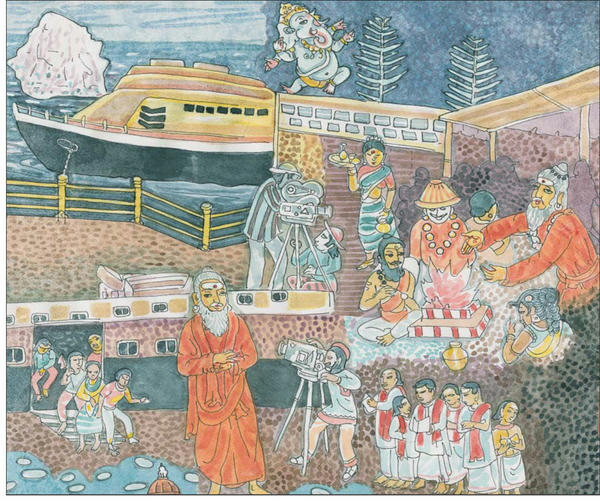
During the Innersearch cruise in 1999, Gurudeva founded Alaska’s first Hindu temple, inviting native Inuit elders to join in the homa. A cruise with 54 devotees in 2000 through the Caribbean did much to fortify Hindus, especially in Trinidad.
• • • • • • • • • • • • • • • • • • • • • • • •§
“Make it Last a Thousand Years”
Iraivan was an improbably difficult project. It had such difficulties built into it—a global logistical nightmare, a budget that such a small group of renounced men would never voluntarily undertake, a level of shastric expertise that would require much learning and guidance, and exacting rules of construction, such as it must be entirely hand-carved—as to make it nearly unthinkable. Did Gurudeva put this on his Order’s shoulders knowing this generation of monastics would have to be a team to accomplish it, that it would require them to sacrifice, to cooperate, to stretch and grow? Yet he would only see the initial parts of its earthly manifestation, such as the all-important foundation. §
Many were the long and involved discussions, beginning with the geological differences between an ancient India and a young Hawaiian island. Some seventy million years have passed over India, eroding many meters of soil and exposing the bedrock. Everywhere you can see bare rock jutting out from the earth, humongous stones, entire hills and ranges of hills. India is seasoned and settled. It is upon this bedrock that Indian temples have been built for some five thousand years, and it is because of that unmoving and unmovable foundation of rock that they still stand, unfazed by earthquake or flood, unintimidated by time. §
Kauai is everything India is not—young, vulnerable, slathered with a skin of clay and loose rock. Being a mere five million years old, the island’s bedrock lies far below the surface, 80 to 120 feet. The soft subsurface is no place to build a heavy temple, and certainly not the gravity-held structure the Cholas designed. Granite, that crystal-rich, dense and super-hard rock that builders love for its durability and strength, has a weakness: It has little tensile strength, so it cannot tolerate even the slightest bending and torquing without shattering. It is structurally brittle. Should a 12-foot-long roof beam be bent just 1⁄8th of an inch along its length, it would crack and fail, bringing down the roof. §
This zero tolerance for movement of the temple foundation was an early challenge. After abandoning the idea of installing enormously long pilings deep into the earth, engineers finally came up with a clever solution—they would build the foundation as a single, monolithic concrete island, which they call a raft. This man-made rock would mimic the real bedrock back in India. If an earthquake or other force of nature should sink one end of the temple half an inch, the raft would move as a whole, keeping the same relationship among all the pillars and beams and averting disaster. This stone island literally floats on top of the clay soil below. §
To create the raft foundation, designs were evolved that echoed volcanic-ash technologies of the Roman era and heralded a new interest in high-density, fly-ash concrete. The guru of that technology turned out to be a Saivite Hindu engineer at the University of California at Berkeley, and it was this innovative soul, Dr. Kumar Mehta, who brought together the knowledge and the elements for what was in 1999 the largest fly-ash pour in modern times, an event that would put Iraivan on the cover of Concrete Today magazine. §
Gurudeva took every opportunity to insist on the longevity of the temple. Even before construction had begun, he was already looking at the endgame. It must last 1,000 years and more. Every detail, every plan, every decision consulted this touchstone. Perhaps it was his way of saying that his work, and that of his Order, was destined to persist beyond a lifetime or two, a call to his monks to set their sights on a more-than-your-lifetime horizon.§
Inside the monastery, that one decree had a powerful impact, widening the scope of the monks’ minds and plans, engaging them in a future that would be for others and not themselves. The thousand-year rule would be applied to the endowments, to the publications and more.§
In Gurudeva’s trips to India, he had seen many majestic temples that had fallen into neglect, with too little funding to maintain them, staffed by an inadequate handful of underpaid priests. Determined that Iraivan never suffer that fate, Gurudeva established a permanent maintenance endowment, stipulating that half of every dollar donated go into that endowment. In this way he ensured that Iraivan Temple will continue to flourish into the far future. So central was this idea to his planning, he decreed that the temple could only be consecrated once the endowment reached $7.2 million, an amount equal to the estimated cost of the project. This endowment was designed to provide sufficient income that the monks will never again have to raise funds to care for the temple.§
On August 21, 1999—24 years after his threefold vision of Lord Siva—Gurudeva witnessed the pouring of his temple’s foundation. In an all-day effort, a forty-man team poured a two-foot-thick base of concrete. One week later, the second two-foot layer was added. Visitors from the island joined Gurudeva to watch the thrilling sight as 20 trucks in 108 round trips placed the 56-foot by 117-foot by 4-foot-deep high-density plinth for Iraivan Temple.§
Gurudeva stood at the far end of the foundation during those days, his arms outstretched ecstatically, smiling the smile men have when they know they have done something amazing. In early November of that year, he emailed all the monks this inspiring message received from the devas:§
Iraivan’s foundation is coming alive. Light is vibrating through it. It is a remarkable sight to behold. Something we never expected or anticipated. What is happening is yet to be known. Seemingly, it is of itself a Being, beautiful to behold, to be approached with awe. Yet, its only form is the form of itself, radiating light in billows and rays, as of many-colored rainbows.§
After curing, the foundation was carefully inspected, and Dr. Mehta’s controversial technique was vindicated. For the first time in 2,000 years, a massive concrete slab had been placed without rebar, and there was not a single crack—not even a hairline fissure! §
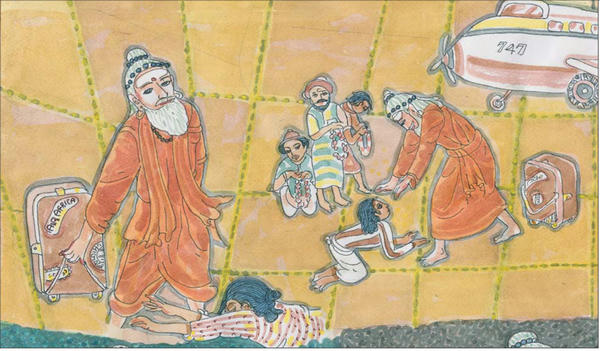
Throughout the 1980s and 90s, Gurudeva traveled frequently to all corners of the world, greeted by each nation’s Hindu communities, speaking at temples and inspiring students and members.
• • • • • • • • • • • • • • • • • • • • • • • •§
Following the foundation pour, Gurudeva began a new pattern. After the monastery’s weekly homa in Kadavul Temple, he would have the monastic priest light a camphor flame from the homa fire, and all would join in a grand parade out to the Iraivan Temple site. Gurudeva conducted a brief homa, started from that flame, in the yagasala just north of the Iraivan foundation. Then, using the kumbha that was blessed at the homa, Gurudeva would lead everyone in circumambulating the temple foundation three times while sprinkling the kumbha water here and there, all the while visualizing Iraivan Temple rising on the spot in the years to come. He was plying his mystic skills to nourish the budding temple as one might nurture a young plant. §
It was the next development in a routine he had followed for four years prior to the foundation pour. Periodically after the early morning puja in Kadavul Temple, he led the monks and members out to the Iraivan Temple site and offered the arati to a tiny Ganesha embedded in the banyan tree behind where Dakshinamurti now stands, just north of the temple, then led a procession around the heart of Iraivan, the below-ground crypt that marked the future position of the Sivalingam. In these holy excursions he was consciously transmitting the spiritual power of the long-established Kadavul Temple to the future Iraivan, training his shishyas to manifest the temple that would one day stand there. “Visualize, materialize,” he loved to say to everyone. To him, it was as real in its inchoate state as it would one day be on the physical plane. §
In May of 2001 Gurudeva participated in the ceremonial placement of the first block of stone. Chief architect V. Ganapati Sthapati, who was flown from India to officiate, spoke to the large gathering after the rituals:§
Years ago Gurudeva invited me to come to the US. I had never been here before.... He told me I should come and help build the Hindu temples in North America. §
Now I wish to relate to you a true story. You may know about the famous Nadi Shastra readers we have in India. They have large libraries of olai leaves with prophecies. Before I met Gurudeva I went to one of these. He read my nadi leaves and said: “The great King Rajaraja Chola has been reborn; he is a tall man with white hair, and he will soon come to ask you to go to the West and build temples there.” And I tell you it was only later that I met Gurudeva and realized that he was the reincarnation of Rajaraja Chola. So this temple has special significance. It is one of only three sacred temples that face south. This means the temple has the power to grant liberation, moksha.§
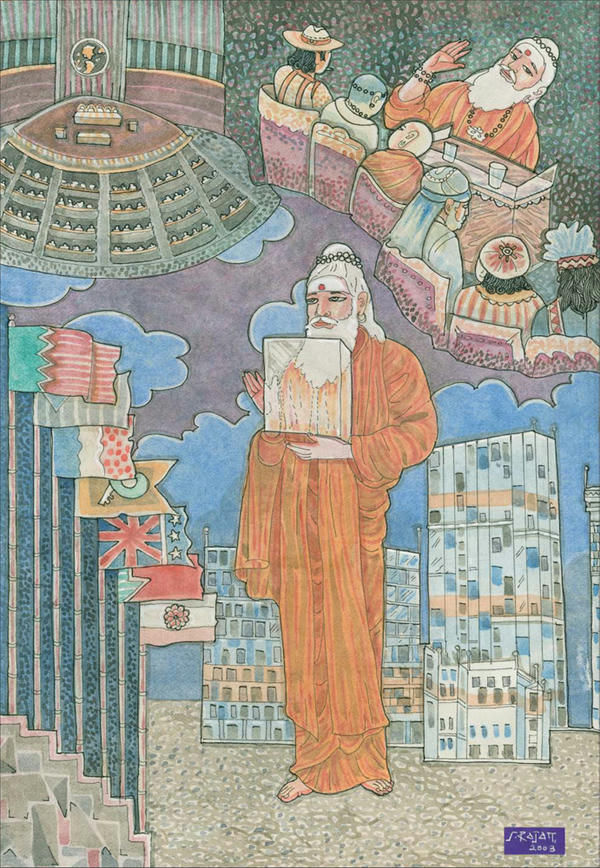
The United Nations’ Millennium Summit in 2000 was history’s largest gathering of world leaders, and the first time that religious leaders joined in the General Assembly Hall. Gurudeva gave a talk on peace to 1,200 leaders and received the prestigious U Thant Peace Award from Sri Chinmoy.
• • • • • • • • • • • • • • • • • • • • • • • •§
Recognition, Local and Global
In September of 1999 Gurudeva traveled to Mauritius, Malaysia and Singapore, meeting members who had not seen him for eight years. He met with national leaders, ministers and VIPs and on Ganesha Chaturthi opened the new Panchamukha Ganapati Mandapam, the centerpiece of his Spiritual Park that would grow to be the premier spiritual nexus of Mauritius. §
A year later, at the end of August, Gurudeva received the U Thant Peace Award from Sri Chinmoy in the Dag Hammarskjöld Auditorium at the United Nations headquarters. This honor had previously been bestowed on the Dalai Lama, Nelson Mandela, Mikhail Gorbachev, Pope John Paul II and Mother Teresa. §
A few days later, Gurudeva and three monks traveling with him attended the Millennium World Peace Summit of Religious and Spiritual Leaders, held in the United Nations’ General Assembly Hall. At the nearby Waldorf-Astoria Hotel, Gurudeva addressed the 1,200-strong spiritual assembly from all faiths, speaking on “Forgiveness and Reconciliation” and offering a summary of his UN message “For World Peace, First Stop the War in the Home.”§
Upon his return to Kauai, 350 citizens and county and state officials gathered on October 18 to herald his accomplishments on the island and beyond. Mayor Maryanne Kusaka and County Council Chairman Ron Kouchi arranged a luncheon at the Terrace Restaurant at the Marriot Hotel. Island leaders and Hawaii Governor Cayetano’s representative Roy Nishida spoke eloquently of Gurudeva’s remarkable effect on their lives and on this island, the many ways he had influenced them. Ron Kouchi gave an amazing talk on prejudice, confiding, “When I first met the monks, with their strange clothes and long beards, I didn’t know who they were or why they were on the island, and furthermore I didn’t want to know. Then through the vision group I came to know them, to see how Gurudeva works, how he brought us all to think of ourselves as Kauaians; and now, four years later, I can say he has changed my life, has become the most influential person in my adult life.” §
The leaders of the island appreciated Gurudeva’s firm policy of being politically neutral (his monks never vote, but support whomever is elected) and his instructions to his monks and family members to be good citizens, never asking for or expecting special favors from the government, always contributing and never taking.§
Who would have guessed that a hazel-eyed American guru would establish a traditional monastery in Hawaii that the whole Hindu world would look up to as a source of knowledge, authority, influence and inspiration? Kauai’s Hindu Monastery had become something of a legend, attracting the praise of the greatest of Hindu swamis, leaders and thinkers, all of whom who were charmed by its unlikely existence and impressed by its purity and authenticity. Gurudeva’s monastery and order are held up as an example of how Hinduism might survive the traumas of the past. If the Sanatana Dharma could thrive in Hawaii, people thought, might it not also survive in India? There were apocryphal tales of his past life as Swami Vivekananda or Rajaraja Chola, and hints that Siva Himself had incarnated to save Saivism. Gurudeva smiled to hear such accolades. §
Jayendra Puri Swami, head of Sri Kailash Ashrama Mahasamsthana Math, Bangalore, observed: §
This birth of Sivaya Subramuniyaswami is a very rare birth. To learn and practice a religion that did not belong to your land; being an outsider and contributing so much to Hindu religion is amazing. He has been able to teach Hindus how to be a Hindu. My guru, Tiruchi Swami, a realized jnani himself, has repeatedly said more than a hundred times that Sri Sivaya Subramuniyaswami is an avatar of Lord Karttikeya, the Commander in Chief of the divine army. Tiruchi Swami said of Gurudeva’s books, “No one in India has been able to do such tremendous work.”§
Swami Paramananda Bharati, attached to Sringeri Pitham and famous for chanting Aum in the Kremlin at the Moscow Global Forum, echoed: §
No one could equal Gurudeva in inspiring Hindus all over the world. He was a Siva bhakta to the core, but without a trace of fanaticism. His vision of Hinduism was total, his approach rational and his love universal, pure, soothing and irresistible. I have never seen a person who is so integral.§
Swami Bua Ji Maharaj of New York declared:§
The sublime substance of Saiva Siddhanta was succinctly spread all over the world by this saint. How was this possible for somebody who was born and brought up in a totally different culture? It could not be anything other than an unbreakable bond from the previous birth, purva janma bandham. The spiritual awareness brought about by him among the Hindus of Western countries is just amazing. Gurudeva’s unique method of explaining the most complex principles in the simplest way was astounding. The most complicated philosophies appeared as the simplest and easiest messages in his hands, but with the same power and essence.§
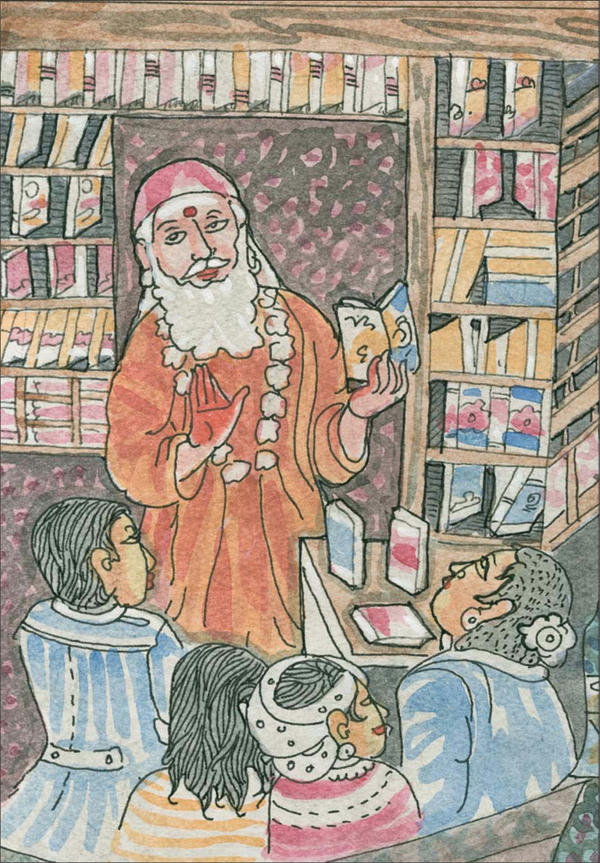
Gurudeva worked hard on his books and knew they were without equal. Bookstores like Borders and Barnes & Noble knew, too, and invited him to introduce the books to readers at book signings all around the country.
• • • • • • • • • • • • • • • • • • • • • • • •§
Painful Karma
On December 5, 2000, Gurudeva and three of his senior monks hiked to the top of a nearby hill to see the new lands the monastery had acquired across the river. The hill was steep, and on the way down Gurudeva slipped. Though he did not fall, the force of the movement badly injured his lower back. He was in severe pain, and asked to stay at Hale Makai, the monastery’s beach-side retreat in Kapaa. For the next four months he stayed there, 150 feet from the ocean and five miles from the monastery, preferring to heal away from his normal onslaught of duties, and closer to the doctors and therapists who would attend him. Each day at lunch and dinner two or three monks drove down from the monastery with a hot meal for him and his three monastic caregivers, to be with him, talk story and enjoy some personal time with their satguru. §
Knowing that the European Innersearch was just months away, he set a major recovery plan and worked powerfully each day to heal his body. His Pilates therapist would later confide that he had never seen such an amazing healing take place, never seen an injury that would debilitate most people for years resolve itself in mere months, even in young athletes he had worked with, let alone in a man of 73. The x-rays were almost unbelievable, when before and after were set side by side. §
Gurudeva did more than just heal during those months. He kept his mind active, working with his editing team every day. The goal he set was to complete Living with Siva, the third and final book of his Master Course trilogy, before the Innersearch departed in August—not a small paperback, but another 1,000-page masterwork. His willpower was astonishing during those months. As he pushed his body and his mind, the goals toppled before him, the book going to press in July and his body ready to travel the world by August. §
Sailing the Seas of Northern Europe
Innersearch Europe followed on August 10-22, 2001, with seventy-two Innersearchers sailing through Northern Europe on yet a more massive ship, the 780-foot, 2,000-passenger MS Amsterdam, then the largest and newest in the fleet. Before the cruise, Gurudeva visited London and Germany, connecting with the Tamil communities there. Groups of seekers were waiting at each port to greet the guru from afar, in Helsinki, St. Petersburg and Warnemunde. In Oslo and Stockholm, small Tamil communities brought Gurudeva to their temples to give talks. Gurudeva brought Russian followers aboard the ship and conducted a namakarana samskara for one in the Neptune Lounge. §
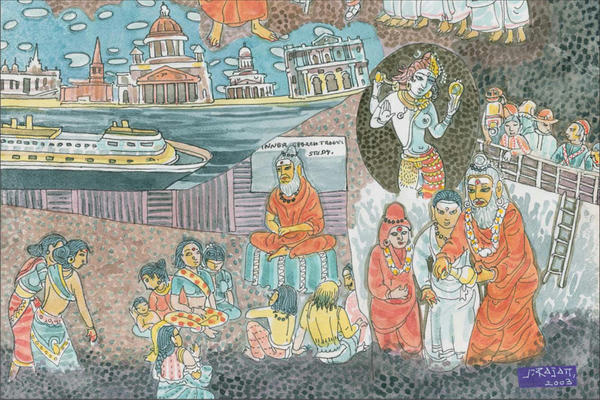
On his last and longest Innersearch cruise, with seventy-two devotees, Gurudeva visited a dozen nations in Northern Europe and Russia, giving talks to Hindu communities and laying the foundation stone for a major temple in Denmark.
• • • • • • • • • • • • • • • • • • • • • • • •§
The international group of Hindus and ardha-Hindu seekers who gathered for this journey stood out on the ship, all those elegant saris and veshtis moving toward the meditation hall while everyone else was there to eat and gamble, swim and shop and sit for hours on the sunny deck. Gurudeva was the center of attention, especially at night. He loved to enter the five-star dining room, walking down a two-story staircase followed by his entourage of monks. Each night as this little drama unfolded, the noisy background sounds of the diners would turn silent in an almost startling way as a thousand passengers stopped eating to watch the elegant, saffron-clad guru descend into their midst, nudging each other as if to say, “Look. Who is that man?” Once he settled, a percussion of clatter would break the silence as, all at once, knives and forks went back to work on expensive china. One day he was challenged, “Why do you go on these five-star cruises?” He quietly retorted, “Because they don’t have six-star cruises yet.”§
After the cruise ended in Copenhagen, Gurudeva and his monastic staff flew in a prop plane to Denmark’s far north, where he laid the foundation stone for an Amman temple in Brande and joined the Hindus of Herning for a festive ceremony in their remote Ganesha temple. It was a challenging journey for Gurudeva, due to his debilitating back injury and the illness he did not know he had. Still, he strode through nation after nation, never complaining, always cheerful and ready for the next experience. No one knew, not even he, that he had just a few months to live.§
In his daily classes in the Hudson Room, Gurudeva covered a stunning array of subjects, including gratitude, seeing God everywhere, the yamas and niyamas, sadhana, family togetherness, the spirit of the guru, the Nandinatha Sutras, zero tolerance for disharmony, growing old, the need for religion, the power of penance and standing strong for Hinduism. He loved the question-and-answer times and patiently fielded everyone’s queries and concerns. In his cabin he kept close to the monks and kept the monks close, coordinating details of the day, adventures on land, changes in the plans, waiting, without saying a word, for a monk to offer to rub his weary feet.§
Life’s Most Exalted Moment
On October 6, 2001—just weeks after Gurudeva returned from that arduous, multi-nation trek through Northern Europe—he was admitted to Wilcox Hospital for severe anemia. During a three-day stay, doctors discovered he was harboring advanced stage cancers in his colon, small intestine and brain. Gurudeva returned to Hale Makai; and over the next week, teams of doctors on Kauai, in California and in Seattle pored over test results and confirmed that he had not long to live. §
On October 16, after a few days of reflection, he gathered the senior monks to inform them of his decision to fast to death. He had taught the traditional way of leaving the body, called prayopavesha, and now he would follow that difficult regimen, preferring the conscious departure of the yogi to weeks or months of medical intervention and systemic deterioration leading to loss of consciousness. He had always spoken of death as life’s most exalted moment, so the monks were not surprised by his decision. They remembered that other great souls, like Ramana Maharishi, who also had cancer, had left life consciously in this way. §
Gurudeva was matter-of-fact in his decision. He asked how long it would take, and after hearing some stories about others who had fasted in this manner, said, “So, in about twenty-four days it will be over and I will be on twenty-four-hour service.” That theme was repeated, as he sought to console the monks that now he would be with them around the clock, not just during sixteen waking hours of the day. “It’s a good time now, while you are all young,” he observed. Still, the monks’ lives were dramatically changed, their world turned upside down, in those critical few days. §
On the evening of the 16th he returned to the monastery, where the monks had set up a special bed in his Mahogany Room. In the ensuing weeks, his own departure was not the most onerous work. It was the sorrow in the hearts of his monks. Hoping to heal their hurt, he assured them, caressed them, offered encouragement and solace. Not a syllable of complaint was uttered. At one point he whispered, “Everything that is happening is good. Everything that is happening is meant to be.” §
From his fasting bed he gave guru initiation to his three successors and signed a few critical documents that such circumstances require. But mostly he was working to leave the body—not an easy thing to do, it turns out. The approach of death held no fear for him, but it did focus him, as he undertook this last great sadhana, diving into the transition with the same fervor that defined all of his works. When monks would come to commune, he would softly instruct, “Sit in silence and we will communicate.” There was work to be done, and it was not to be interrupted by chatter about the past or the future. The work was before us now. His work: to resolve all karmas and depart through the crown chakra. The monks’ work: to aid his transition and prepare for a life without him.§
One evening after asking if the monks had had dinner, Gurudeva sat up, pressed his palms together in namaskara and in a weak voice offered the following message:§
People say, “I sleep eight hours a day, and that is a fact of life.” They say, “I eat three meals a day, and that is a fact of life.” You say, “You are the Self,” and they say “That is not a fact of life.” That is ignorant, erroneous thinking that blocks you from knowing the Self. Those blocks come from Western concepts. §
When one of the monks asked for advice about realizing the Self, Gurudeva responded: §
You have to realize that you already have it. It’s not something you are going to get or that is out there in time. You already have it. So, you think on that. First admit to yourself that the Self is in you. The end of the light is im kaif. Admit that the Self is not apart from you. It pervades everything, creates everything and destroys everything. You are the Self right now. Get that strong in your mind and write down and burn up everything that is opposite to that, then you will be the Self all the time. §
First, accept the fact that you are the Self already. Then, the end of the “eee” is im kaif. Realize the Self. Whatever comes up in your mind to keep you from the Self, write down and burn. That’s all you have to do. It’s very simple. You have all the tools. The only thing then is to realize the Self again.§
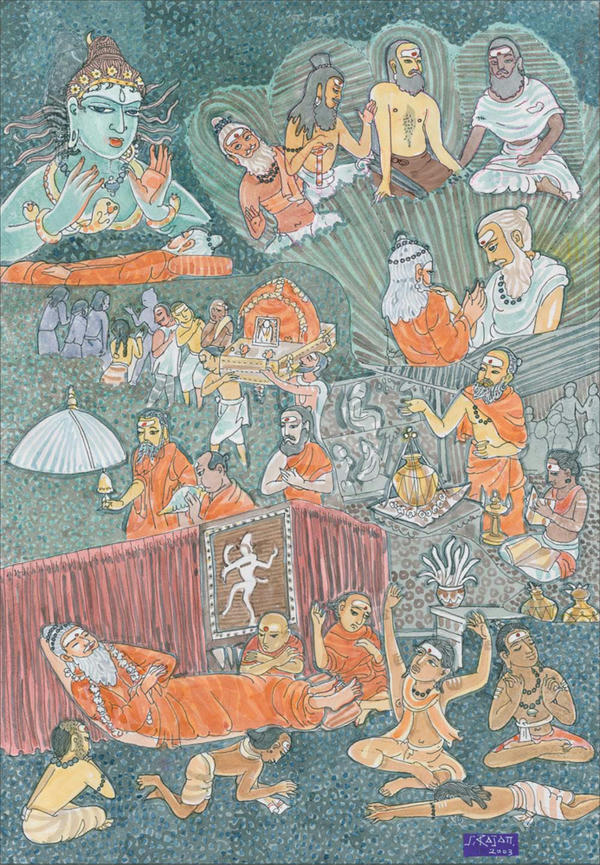
Learning of his incurable cancer, Gurudeva declared he would fast to death. For 32 days his monks stayed at his side, finally carrying his body on a palanquin to the cremation fires. A mystical puja called all the past gurus to come and escort him to Siva’s abode.
• • • • • • • • • • • • • • • • • • • • • • • •§
A senior monk placed the Self God talk, in Gurudeva’s handwriting, in his hands and asked if the monks could read it aloud. “Yes,” was his simple reply. Taking turns, each monk read a few lines. In the dim light, the room bristled with shakti. Those profound words spoken in those varied voices in this timeless moment were mesmerizing. After the reading, Gurudeva commented, “So, the Self God was true in the 50s and it is still true in the 2000s.” All present laughed in acknowledgment that the Absolute Truth is always the same, always true, transcending life and death.§
One day Gurudeva was greeting astral guests. Sitting up in bed, he would raise his hands in namaskara, acknowledging each one. At one point, in the dark of night, he told the monks that Yogaswami had come to him and said, “Everything is finished. All is complete. I will be back.”§
Devotees poured in from around the world to be near their satguru in these final days, though he had requested only the monks should enter his room or see him. But his noble shishyas were there, in love and appreciation for his gifts and guidance. He had transformed their lives and had taught them the importance of being in close proximity to the satguru during mahasamadhi, the shakti of which tradition says is greater than a thousand dips in the river Ganga, a thousand pilgrimages to Mount Kailas, a thousand grand yajnas. §
At 11:54pm, during Chitra nakshatra, November 12, 2001, after fasting for 32 days, Gurudeva attained mahasamadhi, minutes before the dawn of Dipavali, Hinduism’s festival of lights. A lifetime of courage and willpower was crowned by a noble departure which showed the world, and all who suffer their final days, the continuing relevance of an ancient approach to death. An hour later all the monks assembled in the monastery’s Guru Pitham, as he had decreed, to install his designated successor, Satguru Bodhinatha Veylanswami, the order’s senior monk, and to prostrate to him for the first time, thus beginning a new era—the era of the next preceptor in the age-old Kailasa Parampara. §
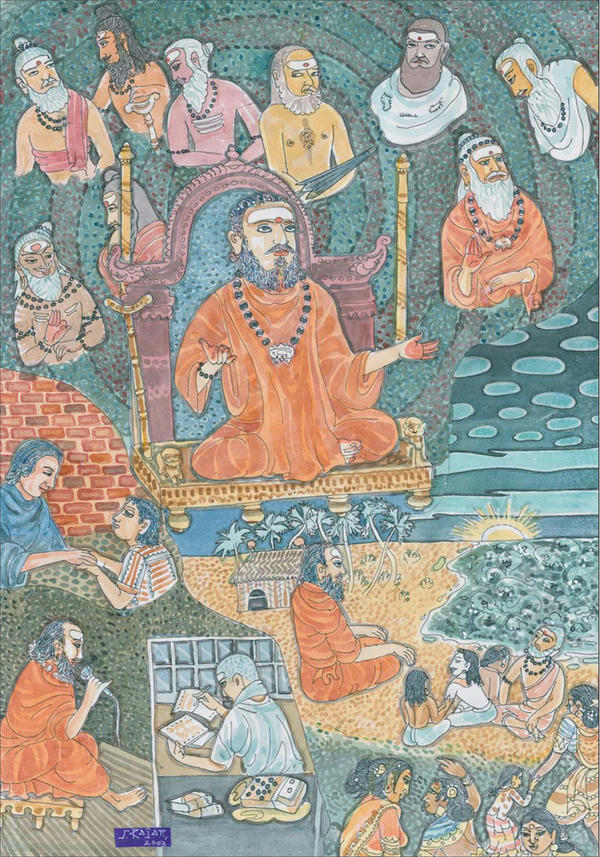
Satguru Bodhinatha Veylanswami was installed on November 13, 2001, as the Guru Mahasannidhanam of Kauai Aadheenam. His earlier life as a monastic teacher and accountant and a meditating sadhu would change as he set forth to represent the Church and perpetuate Gurudeva’s life work.
• • • • • • • • • • • • • • • • • • • • • • • •§
As a youth of 21, while still studying at the University of California at Berkeley, Bodhinatha first met Gurudeva in a brick-walled room at the Mountain Desert Monastery in Nevada. Joining Gurudeva’s order in 1965, he was the guiding administrator of Gurudeva’s institutions for decades, overseeing their legal and business matters. In the 1970s, Gurudeva sent him to the Big Island of Hawaii, there to live alone in a crude thatched hut on the ocean sands for nine months. Gurudeva would fly to Kona to visit and guide Bodhinatha’s sadhana and meditations. Such service and sadhana had prepared Bodhinatha for the momentous responsibilities placed on his shoulders. When Gurudeva stationed him in Sri Lanka for six months in 1972, Yogaswami spoke into his right ear, saying, “I am preparing you for your/my mission.” With the humility that defined his monastic life, he ascended the pitham and became the next in a long succession of Nandinatha satgurus. §
The following afternoon the monks and shishyas carried Gurudeva’s body in procession to the monastery entrance. Unexpectedly, a police escort, arranged by the mayor who loved him so, sped the entourage to the crematorium, with police cars stationed at every intersection of the 20-mile ride, stopping all traffic along the route, as though Kauai’s favorite spiritual master must get to Siva’s feet without another moment’s delay. Hundreds of people were there to say goodbye at an emotionally charged memorial service, replete with a Hawaiian hula halau offering mystical chants and dances in a riveting outpouring of love until the senior monks, chanting “Aum Namasivaya,” carried his body on their shoulders the last few feet to the modern pyre. The New York Times, CNN and others announced his passing. §
At dawn the next day, the monks gathered his ashes and brought them to the monastery, placing them, as he had instructed, in the wall of an underground cave behind the Guru Pitham. From that day forward his life and legacy have been honored at a monthly guru puja on the day of Chitra nakshatra at a shrine the monks built in the main mandapam of Kadavul Temple, on the spot he sat hundreds of mornings to give spiritual guidance to his devotees. Jai Gurudeva!§